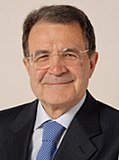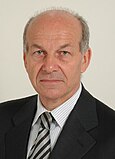Italian centre-left primary election, 2005
|
|
|||||||||||||||||
|---|---|---|---|---|---|---|---|---|---|---|---|---|---|---|---|---|---|
|
|||||||||||||||||
|
|||||||||||||||||

Primary election results map. Purple denotes provinces with a Prodi plurality.
|
|||||||||||||||||
The 2005 Italian centre-left primary election determined the leader of the coalition The Union, who will stand as common candidate for the office of Prime Minister in the subsequent general election, which will take place on 9–10 April 2006. It was won with 74% of the votes by Romano Prodi.
As of 2005, the coalition was assumed to be led by Romano Prodi, however he called for a primary election in order to gain an official leadership. Primary elections were a novelty in Italian politics, as the proportional system in place until the early 1990s was supposed to present sufficient variety to electors. With the new majoritarian electoral system, two clear blocks emerged since 1996.
Primary elections had never been held on a national level before in Italy, and only once at a regional level, in Apulia: in that occasion, Nichi Vendola, a communist and gay Catholic, became the candidate for the centre-left coalition in a region reputed to be conservative and with deep religious roots. The institute of primary election came under criticism from some centre-left moderates, as in their opinion it had produced a useless candidate doomed to failure. However, Vendola's victory against the incumbent governor and centre-right candidate Raffaele Fitto, a much more conventional and moderate young man, vindicated the primary elections in the internal argumentations of The Union.
When the primary elections were first proposed, they were mostly meant as a plebiscite for Romano Prodi, since there were no other candidates to the leadership of the coalition. The secretary of the Communist Refoundation Party, Fausto Bertinotti, then announced he would run for the leadership, even if only to act as a symbolic candidate, to avoid a one-candidate election. After some time, more candidates were presented.
...
Wikipedia


